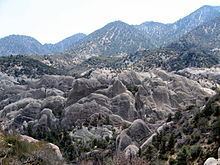 | ||
Similar Angeles National Forest, Modjeska Peak, Mount Baden‑Powell, Mount San Antonio, Bridge to Nowhere | ||
Devil's Punchbowl, elevation 4,750 ft (1450 m), is a tilted sandstone formation on the northern slopes of the San Gabriel Mountains, in Los Angeles County, California.
Contents
Map of Devils Punchbowl, California 93553, USA
Park
The Devils Punchbowl Natural Area is a Los Angeles County park, also within the San Gabriel Mountains National Monument and Angeles National Forest. It is located south of the Pearblossom Highway (CA Route 138), near the towns of Littlerock and Pearblossom.
Short trails within the park showcase the geologic features along the Punchbowl and San Andreas Faults. There are connections to major longer trails leading to the high country in the National Monument.
The Devil's Punchbowl Nature Center is operated by the Los Angeles County Department of Parks and Recreation. The center focuses on the flora, fauna, and geological features of the park, and the center offers school programs, parties, guided park tours, as well as telescope programs with an 11-inch telescope.
Geology
The primary attractions of the park are its geological formations, including the Punchbowl Formation of the Neogene period. The Punchbowl is a deep canyon categorized as a plunging syncline: a v-shaped folding of the earth's strata caused by compression. The mountain peaks above the park are 8,000 feet in elevation, compared to the park's Nature Center at 4,740 feet above sea level. The Punchbowl Canyon is 300 feet deep at the vista point.
The peculiar uptilted rock formations found in the area are layers of sedimentary rocks formed long ago by water depositing loose material in horizontal layers. Later they were squeezed into their present, steeply tilted form by ongoing uplift action along the Punchbowl and Pinyon Faults and by pressures along the San Andreas Fault. The Punchbowl Fault is to the south of the rock formation, while the Pinyon and San Andreas Faults are to the north.
Flora
Vegetation contributes greatly to the particular appearance of any landscape, and it is rewarding to look at native vegetation as plant communities. Driving to the park, beginning down on the flats of the Antelope Valley, there is almost a complete absence of large shrubs or trees. The road then climbs into a belt of Joshua trees and California junipers. As you enter the park boundaries, the Joshuas are left behind and you enter a region dominated by Pinyon pine Woodland, with shrubs of the Desert Chaparral as an understory. The streambeds, both Punchbowl Creek at the bottom of the bowl and other watercourses in the Antelope Valley, have their own type of vegetation with cottonwoods, willows, and other plants that require more water. The next plant community above the park is the Coulter Pines and Yellow Pine Forest of the higher San Gabriel Mountains. Above these trees, White Firs are silhouetted against the sky on the high slopes and peaks.
Fauna
Many types of mammals live here but most are nocturnal and are seldom seen. Gray foxes may sometimes be seen in the early mornings or at dusk, and you may occasionally see deer crossing the road. Chipmunks and California ground squirrels are active during most of the day. A few common birds are on display, and many additional species migrate through the area at various times of the year. The park's reptile and amphibian fauna represent a unique blend of types found in both deserts and mountains. Examples of some common local reptiles and amphibians are on display. Rattlesnakes are also common but are wary of people and are rarely encountered. Insects and spiders are seasonally abundant. They may be seen on flowers and shrubs throughout the park, especially during the spring and summer. A representative collection of the various orders of insects is on display.
Filming location
The Australian band Wolfmother recorded their music video for the song "Mind's Eye" at the Devil's Punchbowl. Additionally, German heavy metal band Accept filmed a video for their song "Stampede" at the location.
